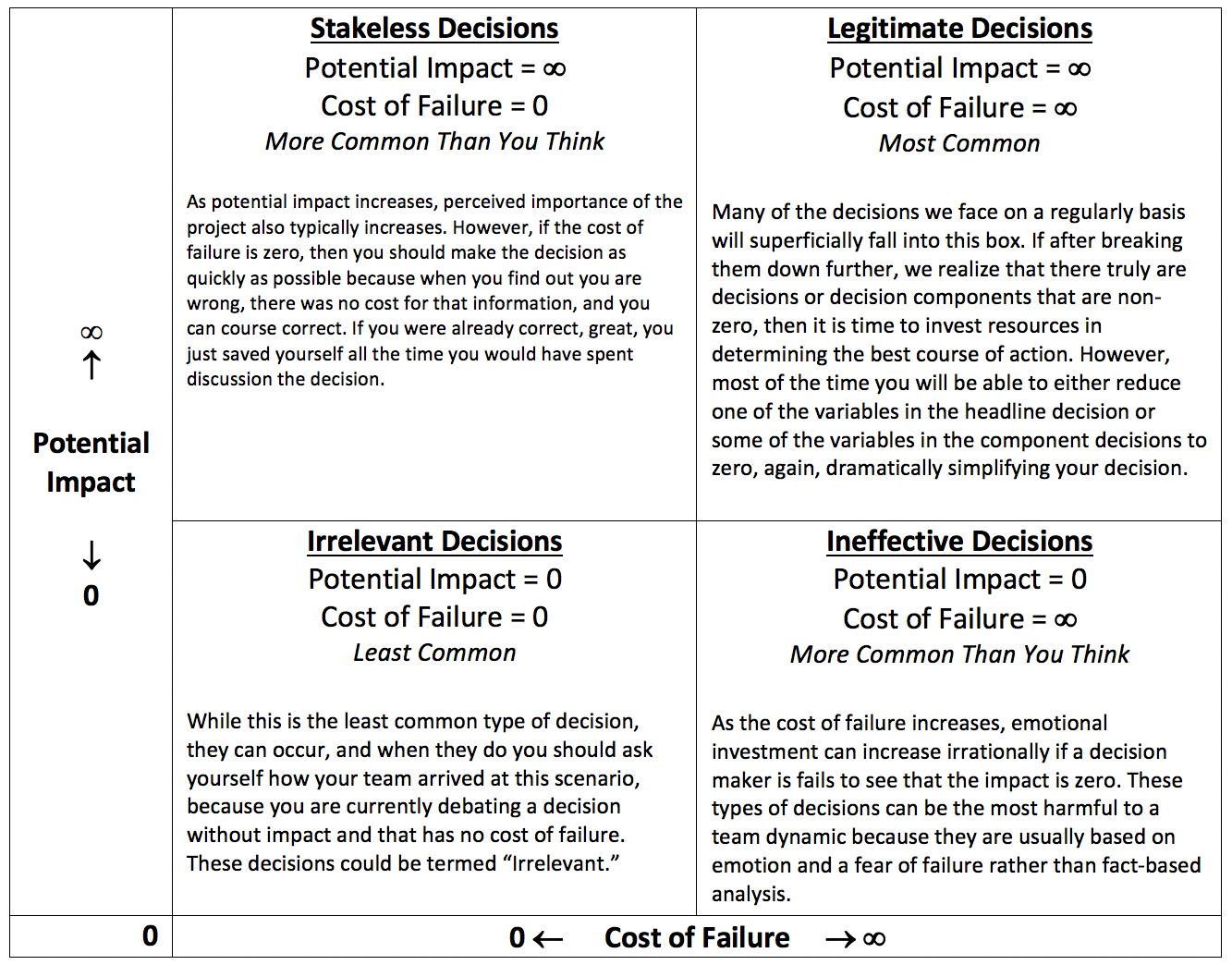Decision Making Factors – Incorporating Impact & Cost of Failure
Summary
- When deciding what degree of effort to invest in terms of information gathering and data analysis related to the decision at hand, two of the most significant factors to consider are the potential and actual impact of that decision as well as the possible cost of failure or choosing incorrectly.
- This reduces to a fairly simple but helpful equation:
- Effort to Invest in Making a Decision = Potential Impact * (Cost of Failure or Choosing Incorrectly)
- Shorthand -> Decision Time/Effort = Decision Impact * Incorrect Decision Cost
- One of the most interesting attributes of making decisions with this formula is that the components are multiplied, which results in conclusions that are not necessarily intuitive when either one of the components is equal to 0.
- If Potential Impact = 0
- If you perceive the potential impact to be low or 0, then you shouldn’t spend time on that decision because the outcome won’t change anything.
- We could also term these decisions “ineffective” because without significant impact, the decision won’t affect change in whatever domain it is located.
- If Cost of Failure = 0
- If you perceive the cost of failure / choosing incorrectly as 0, then you shouldn’t spend time on that decision even if it has a large impact, because it will cost nothing to choose again.
- We could also term these types of decisions “stakeless” because the decision maker loses nothing by making this choice even in the worst outcome.
- If Potential Impact = 0
Detailed Discussion
Good decision making is incredibly complex, but I have found several rules, equations and mental models that can dramatically simplify the resources required to make a given decision.
While impact and cost of failure may seem simple on the surface, I have been part of dozens of conversations where both of these variables were zero, and the decision could have been reduced from months to minutes. Recognizing when either of these variables is zero can be a high leverage way in which to increase your or your team’s productivity. As an aside, the value of information that you believe could reduce any of these components to zero is extremely valuable.
In this case, it is most helpful to first look at a logical grid of potential outcomes and second to examine a “real world” example.
Outcome Grid
While you won’t typically face decisions where these variables are infinite or zero, taking the concepts to their logical and nominal extreme is helpful in two ways:
- First in putting many of the decisions we believe to be important into perspective.
- Second in illustrating the value that can be created if you reduce the nominal value of either or both variables.
In reading the chart, it is also helpful to think of the variables in both cases as approaching the extremes of 0 and infinity, as the two decision variables discussed here may approach those values but will likely never reach them.

“Real World” Examples
Let’s take a look at an example that relates these concepts to actual decisions:
- College/Law/Medicine/Business School Selection – Stakeless Decision
- School application and selection is perceived as one of the most significant decisions that prospective students will make in their lifetime. As a consequence there is an entire industry dedicated to providing counseling and information services that help individuals debate their choices.
- While not applicable in every case, I would argue that most students in a given band of academic distinction (assume that is the only variable at play in terms of admissions for sake of discussion) obtain admission to at least one school among the group to which they applied and desired. For example, if I am an American high school student applying to Top 50 Universities, given that I am qualified and can obtain admission at one of those universities, I’ll likely obtain admission at more than one.
- Given our decision modeling above, it also follows that the choice the student makes in terms of which school they will attend is not as impactful as it may seem. Ignoring extreme outliers, most schools in a given band will provide a similar level of education, networking and extracurricular opportunities to each student, so while the impact that a given school will have on an individual is relatively high, the cost of choosing the “wrong” option is zero, because any one choice in the set of schools to which the student was admitted would by our measure be equal.
Decision Recursion?
- See Wikipedia’s explanation of recursion if you are unfamiliar with the concept.
- Another interesting example is that while your headline decision might have values for both variables, some of the decisions that make up your headline decision may not.
- For example, while the headline decision of whether to pursue a given software project might be high impact and also have a high cost of failure, the decision to use new or legacy technology to build the project might have a very high impact, but low cost of failure (low cost to try it out).
- The recursive nature of decision making, combined with evaluating our variables we enumerated above, can produce some surprising situations where you have high stakes top line decisions with many micro decisions that are low stakes. Breaking decisions down in this way is another technique for reducing the resources required to make the decision and move forward.